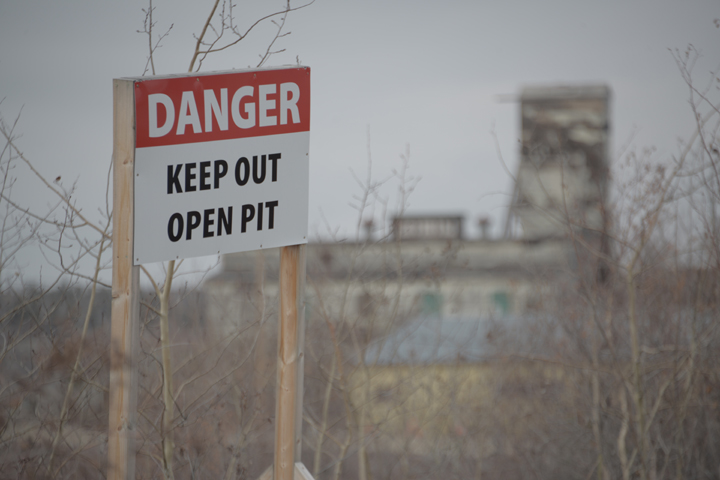WATCH ABOVE: A preview for 16×9’s “Contamination Nation.”

Giant Mine is one of the richest gold mines in Canadian history.
From 1948 to 2004, 200 tonnes of gold was mined from the site just outside Yellowknife, NWT, an amount worth approximately $2.7 billion.
The mine created jobs and economic benefits, and is widely credited with helping build the city of Yellowknife.
But there is another, less celebrated side of Giant Mine, one that could cost Canadian taxpayers nearly a billion dollars.
READ MORE: Arsenic trioxide: What is it is and why it’s so dangerous
The gold extraction process used at Giant Mine created a highly toxic by-product, a dust called arsenic trioxide. Today, there is an almost unfathomable amount of that toxic dust still buried underneath the site.
“There’s 237,000 tonnes of arsenic trioxide stored underground,” says environmental advocate Kevin O’Reilly.
“There’s probably enough underground to kill every person on the planet a couple times over.”
The pollution buried underneath Giant Mine is perilously close to downtown Yellowknife and a vital marine ecosystem.
O’Reilly says if the creek running through the property floods it will have devastating impacts on the environment and the health of people who live in the area.
WATCH BELOW: O’Reilly talks about the toxic arsenic trioxide contamination created by the Giant Mine in Yellowknife, NT
“If the creek somehow freezes up, backs up, jumps over its bank and goes back into one of the pits? Well if it gets into one of the pits, it’s going to get into the underground and it’s going to leach out this arsenic trioxide. Yellowknife is right next to Great Slave Lake, it’s one of the largest freshwater bodies in the world, in Canada if not the world. And this water flows where? Down the Mackenzie River – Canada’s biggest river.”
If that happens, thousands of kilograms of arsenic trioxide could leak out, further polluting land already highly contaminated from the gold mining operation.

Get daily National news
READ MORE: Is there a contaminated site near you?
To stop the arsenic from escaping, a team of government workers plans to freeze the chambers holding the arsenic dust in place, so that no water can get in and carry the contamination into the surrounding soils and waterways.
Those chambers must be frozen, because mining operations destroyed the natural permafrost. The proposed freezing system will cost a staggering $903 million by the time the job is done, plus nearly $2 million per year to maintain it forever, or until new technologies are found to safely dispose of the arsenic.
And taxpayers will pay the entire $900-million bill.
WATCH ABOVE: Former Dene Yellowknives First Nation Chief, Fred Sangris, talks about how the gold at the Giant Mine site was discovered
“Corporations, they’re only going to operate within the laws that exist, that governments are supposed to be putting in place,” says O’Reilly.
“The company is not around anymore, so who is going to have to pay for trying to manage this stuff forever? You and I as taxpayers, that’s who’s going to have to pay for this.”
Since the government never required any of the subsequent companies that owned Giant Mine to take full responsibility to clean up the pollution they caused, taxpayers will pay for it.
The Ministry of Aboriginal Affairs and Northern Development Canada is responsible for Giant Mine. 16×9 wanted to ask Minister Bernard Valcourt why taxpayers, and not industry, are paying for the cleanup, but our interview requests were declined.
And Giant Mine is only the tip of the proverbial iceberg. There are more than 22,000 contaminated sites in Canada that the federal government must now pay to clean up.
Even more galling, it could happen again. Former federal Environment Commissioner Scott Vaughan says even after bad experiences with Giant Mine and other major contaminated sites, Canadian law still doesn’t force companies to pay the full cost of the pollution they create.
WATCH BELOW: An aerial view of the Giant Mine site in Yellowknife, NT. This is one of Canada’s most contaminated places, and will cost at least $900 million dollars to remediate.
“If we know that there’s not enough money for those financial safeguards, then we could be facing the bill in the future as well,” he says.
Vaughan investigated the federal government’s handling of contaminated sites while he was Environment Commissioner in 2012. In his report, he noted the government had decided thousands of sites didn’t need any further action, and marked them closed. But they couldn’t tell him how they’d reached those conclusions.
“If you don’t look that hard then you can just say, well, we don’t think there’s a problem and you close it and the cost then is zero.”
Environment Canada’s contaminated sites index shows 7,456 sites were closed with no further action required, before site testing was done. Several requests to interview Environment Minister Leona Aglukkaq about why those sites were closed, were declined. In an email, Environment Canada staff claimed they had “historical information” that showed closed sites were not dangerous, and therefore, site testing was not necessary.
In April of this year, the Parliamentary Budget Officer estimated the cost of cleaning up all federally owned contaminated sites at $7 billion, and that cost is still going up.
Don’t miss 16×9’s “Contamination Nation” this Saturday at 7pm.







Comments